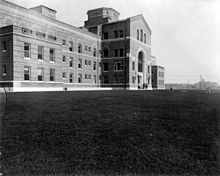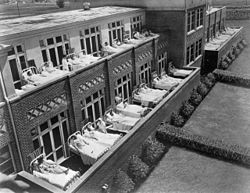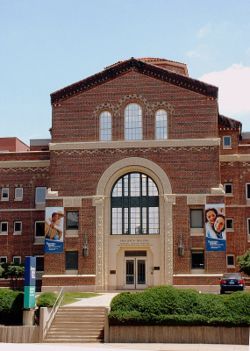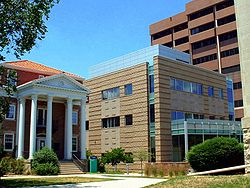- National Jewish Health
-
National Jewish Health 
National Jewish Health, circa 1920. Geography Location 1400 Jackson Street, Denver, Colorado, United States Organization Care system Private, non-profit Hospital type Specialist Affiliated university University of Colorado Denver Services Emergency department N/A Beds 46 [1] Speciality see text History Founded 1899 Links Website www.njc.org Lists Hospitals in Colorado National Jewish Health (previously National Jewish Medical and Research Center) is a research institute located in Denver, Colorado specializing in respiratory, immune and allergic research and treatment. It was founded in 1899 to treat tuberculosis, and is today considered one of the world's best medical research and treatment centers.[2] It is a non-sectarian institution but received funding from B'nai B'rith until the 1950s.[3]
Today, clinical functions at National Jewish are limited to research, diagnosis, and ambulatory outpatient care.
Contents
The clean air and sunshine cure
By the late 19th century, Colorado and the American Southwest had become famous for the health benefits of a dry, sunny climate. At that time, the only known treatment for tuberculosis (TB) was clean air and sunshine and hundreds of people with tuberculosis descended upon Denver in hopes of finding a miracle cure for what was then the nation’s leading cause of death. Consequently, many TB sufferers spent their last dollars coming to Colorado. By the 1890s, it was estimated that one out of every three residents of the state was there for respiratory reasons. However, no facilities existed to provide treatment or shelter to these victims. In Denver, victims of TB were literally dying in the streets as boarding houses often banned "lungers," as they were called.[4][5]
Treatment of tuberculosis
It was obvious that the Denver community at large was not sympathetic to the plight of needy TB sufferers, and many argued that "we can’t blacken the name of the city" by making it a TB refuge. Fortunately, a woman named Frances Wisebart Jacobs recognized the need for a TB hospital. After joining forces with a young rabbi, William Sterne Friedman, the two raised enough money to buy some land and erect a building, and the laying of the hospital’s cornerstone on October 9, 1892 drew huge crowds. The original hospital was completed in 1893 and was to be named the Francis Wisebart Jacobs Hospital after its founder. Unfortunately, due to the combination of the "Silver Crisis of 1893" and a national depression, the hospital did not open and it sat vacant for six years until William Sterne Friedman approached B'nai B'rith, a national Jewish organization, and persuaded them to raise the required operating funds on an annual basis. When the hospital opened on December 10, 1899, it had a new name; National Jewish Hospital for Treatment of Consumptives (consumption is an old name for TB that describes how the highly contagious illness wastes away or consumes its victims). B'nai B'rith continued to support the hospital until the early 1950s.
From its inception, National Jewish has been a non-sectarian institution. As emphasized at the ground-breaking for the hospital on October 9, 1892, it was noted that "….As pain knows no creed, so is this building the prototype of the grand idea of Judaism, which casts aside no stranger no matter of what race or blood. We consecrate this structure to humanity, to our suffering fellowman, regardless of creed." In fact, the first patient to enter the hospital, on December 11, 1899, was a Protestant Swedish woman from Minnesota. To reflect its openness to the impoverished of every background, National Jewish adopted the motto:
"None may enter who can pay -- none can pay who enter"[3]
The hospital opened with a capacity of 60 patients with the goal of treating 150 patients a year. In the beginning, a 6-month limit on patient stays was imposed and only patients in the early stages of TB were to be accepted. In reality, however, many chronic sufferers were admitted and, after a few months, the 6-month limit was lifted. Treatment of TB at National Jewish was in line with other turn-of-the-20th-century TB sanatoria: plenty of fresh air, lots of food, moderate exercise, and close scrutiny of every aspect of patients' lives. The inhabitants of National Jewish could expect to sleep outside, or with their heads outside, every night, and were all but gorged with food. For example, in 1911, the annual report records that $3,631 was spent on eggs (roughly $70,000 today[6]) for just 120 patients.[4]
Research and education
In 1914, National Jewish erected a building for the study of TB. This became the first place, outside of a medical school setting, which research on the disease was done.[4]
Early advances included the nation's first self-contained facility for treating children with active cases of TB, work on anti-TB drugs such as isoniazid (INH), and the use of microbiological assay measurements to determine the proper dosage of INH in the 1950s. These advances were furthered by implementing new TB treatment protocols that substituted physical activity for bed rest and; prescribed a combined drug therapy using streptomycin, INH, and para-Aminosalicylic acid. As TB gradually came under control in the United States, asthma and other respiratory diseases were added to National Jewish’s mission, but a strong presence was maintained in TB research, including the development of better drugs, and expansion of education efforts. Rifampin, the most widely used drug for TB today, was tested at National Jewish in 1970 and two years later, a state-of-the-art laboratory was opened to study difficult TB cases, establishing National Jewish as a highly specialized center for multiple drug-resistant TB (MDR TB) and atypical mycobacterial infections. In 1963, a 1- to 2-week TB control course was offered for specialists from all over the world (and is still offered today). Indeed, over the past 20 years, nearly 5,000 physicians and nurses have visited Denver for the course.[4]
National Jewish Health continues to be a steady contributor in the fight against TB including patients with MDR TB, often providing treatment for the poor at no charge. National Jewish Health is still developing new drugs, in collaboration with leading pharmaceutical companies. The greatest contribution of National Jewish Health in the fight against TB, is, perhaps, education. In addition to the annual TB course offered since 1963, the hospital maintains a Mycobacterial Consult Line, a service whereby physicians anywhere in the world can call and receive free advice from specialists. This service responds to over 2,000 calls annually.[4]
In addition, the Kunsberg School, a day school program for students in grades K – 8, is located on the grounds of National Jewish Health at 1400 Jackson Street, Denver, Colorado. Children who attend the school have medical problems, which may cause frequent absences from school, and may require medical assistance during the normal school day. Each student enrolled at the Kunsberg school is referred by a physician. All economic, racial and ethnic groups are eligible. The school is non-sectarian, and students come from throughout the Denver metropolitan area. There is no tuition at the Kunsberg school, it is funded wholly by National Jewish Health and the Colorado Department of Education.
Present mission
Today, National Jewish Health has no formal ties to any religious or quasi-religious institution and receives no annual funding from B'nai B'rith or any similar organizations. Until 1968, the institution only accepted patients without Health insurance and all care was free.[5] In keeping with this philosophy, free or heavily subsidized care is provided to ensure that patients who are in need can receive the care they need. At the opening of National Jewish back in 1899, the president of the institution, speaking of TB in the heightened rhetoric of that day, declared that it was his dream for the hospital "that its doors may never close again until the terrible scourge is driven from the earth." Now, at a time when the World Health Organization estimates that one out of every three people[7] in the world is infected with Mycobacterium tuberculosis, (the bacteria causes 5-10% of carriers to develop active TB in their lifetime) those doors are still open.
American Health magazine termed National Jewish Health one of the finest U. S. hospitals in allergy, immunology and pulmonology for both adult and pediatric patients The Institute for Science and Medicine rated National Jewish Health among the top 10 independent biomedical research institutions-of any kind-in the world, and the only one that also provides patient care. Since 1998, U.S. News & World Report has ranked National Jewish Health as the best respiratory hospital in the nation,[8] and scholarly publisher Thomson Scientific has ranked National Jewish Health among 25 of the most influential research institutions in the world in its areas of focus.[2]
As National Jewish Health is a leader in the fight against drug-resistant tuberculosis, Andrew Speaker, an individual suspected to have XDR-TB under federal quarantine, was moved to the hospital for treatment on May 31, 2007.[9] The Mycobacteriology Laboratory at National Jewish Health determined that Speaker did not have the Extensive Drug resistant form of TB (XDR-TB), but rather the Multi-Drug Resistant form of TB (MDR-TB).
In August 2007, National Jewish doctors treated XDR-TB patient Robert Daniels, following his nearly year long quarantine in a Maricopa County hospital jail ward. After an extensive legal battle, Daniels was sent to National Jewish Hospital where the Mycobacteriology Laboratory diagnosed Daniels with MDR-TB (rather than XDR-TB). In addition to treating his TB, doctors at National Jewish also removed Daniels' entire left lung.[10]
Areas of speciality
- Allergic conditions (allegies)
- Alpha 1-antitrypsin deficiency
- Asthma
- Atopic dermatitis and other types of eczema
- Autoimmune disease
- Berylliosis
- Bronchiectasis
- Cancer and cancer research
- Chronic bronchitis
- Chronic obstructive pulmonary disease (COPD)
- Cystic fibrosis
- Emphysema
- Environmental and occupational disease
- Immunodeficiency
- Interstitial and fibrotic lung disease
- Lupus (systemic lupus erythematosus)
- Nontuberculous (atypical) mycobacterial infections
- Psychosocial issues related to chronic disease
- Rheumatoid arthritis
- Sarcoidosis
- Sinusitis
- Sleep disorders
- Tuberculosis (TB)
- Vocal cord dysfunction (VCD)
- Other respiratory diseases[11]
See also
- Tuberculosis treatment
- TB Alliance
- Bacillus Calmette-Guérin The TB vaccine
References
- ^ findarticles.com
- ^ a b "Extraordinary Accomplishments at National Jewish". Archived from the original on 2007-09-28. http://web.archive.org/web/20070928122058/http://www.nationaljewish.org/about/hr/glance/accomplishments.aspx. Retrieved 2007-10-16.
- ^ a b "The History and Mission of Health". http://www.njc.org/about/history.aspx. Retrieved 2007-05-30.
- ^ a b c d e Jeff Bradley; Michael Iseman. "National Jewish: The 100-Year War Against TB". Division of Tuberculosis Elimination (DTBE) - TIMS Course Schedule. Archived from the original on 2003-04-27. http://web.archive.org/web/20030427203736/http://www.cdc.gov/nchstp/tb/notes/TBN_1_00/TBN2000Bradley.htm. Retrieved 2007-05-30.
- ^ a b "A Brief History of National Jewish". Archived from the original on 2007-04-15. http://web.archive.org/web/20070415035305/http://www.nationaljewish.org/about/hr/glance/history.aspx. Retrieved 2007-05-30.
- ^ NASA New Start Index Inflation Calculator
- ^ Tuberculosis Fact Sheet: World Heath Organization
- ^ "Best Hospitals 2007 Specialty Search: Respiratory Disorders". U.S. News & World Report. http://health.usnews.com/usnews/health/best-hospitals/search.php?spec=ihqpulm. Retrieved 2007-10-16.
- ^ "Foxnews.com: TB Patient moved to Denver hospital, May 31, 2007". Foxnews.com. Thursday, May 31, 2007. http://www.foxnews.com/story/0,2933,276613,00.html. Retrieved 2008-11-08.
- ^ "TB patient readies for surgery to remove lung". 9NEWS.com. http://www.9news.com/news/article.aspx?storyid=74566. Retrieved 2010-10-22.
- ^ Conditions We Treat
External links
Categories:- Hospitals in Colorado
- Tuberculosis
- Buildings and structures in Denver, Colorado
Wikimedia Foundation. 2010.



